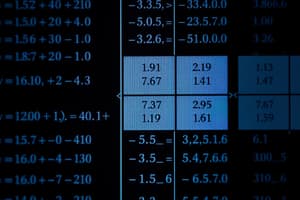Podcast
Questions and Answers
What is a regression line?
What is a regression line?
- A line that shows only the mean of the response variable.
- A line used only to plot historical data.
- A line that cannot be used for prediction.
- A line that describes how a response variable changes as an explanatory variable changes. (correct)
What is the regression line equation?
What is the regression line equation?
ŷ = bx + a
What is a residual?
What is a residual?
The difference between an observed value and the predicted value by the regression line.
What is a least-squares regression line?
What is a least-squares regression line?
What does the standard deviation of the residuals indicate?
What does the standard deviation of the residuals indicate?
What does the coefficient of determination r² tell us?
What does the coefficient of determination r² tell us?
What is the purpose of goodness-of-fit in a linear model?
What is the purpose of goodness-of-fit in a linear model?
What is R-squared?
What is R-squared?
How is R-squared calculated?
How is R-squared calculated?
0% R-squared indicates that the model explains none of the variability of the response data.
0% R-squared indicates that the model explains none of the variability of the response data.
100% R-squared indicates that the model explains all the variability of the response data.
100% R-squared indicates that the model explains all the variability of the response data.
Flashcards are hidden until you start studying
Study Notes
Key Concepts in Least Squares Regression
-
Regression line: Represents the relationship between a response variable (y) and an explanatory variable (x). It helps in predicting y values for given x values.
-
Regression line equation: Expressed as ŷ = bx + a, where:
- ŷ (y hat) is the predicted value of y
- b is the slope of the line
- a is the y-intercept
-
Residual: The difference between an observed value and its predicted value by the regression line, calculated as residual = y - ŷ.
-
Least-squares regression line (LSRL): Aims to minimize the sum of the squared residuals, resulting in the best-fitting line for the data.
-
Standard deviation of the residuals: Measures the typical size of prediction errors; provides insight into the accuracy of the model's predictions.
-
Coefficient of determination (r²): Indicates how well the LSRL predicts y values compared to merely guessing the mean of y. A higher r² signifies better predictive performance.
Goodness-of-Fit
-
Goodness-of-fit for a Linear Model: Evaluates how closely the regression line fits the data by minimizing the distance (squared residuals) between them through ordinary least squares (OLS) regression.
-
Model fit criteria: A good model presents small and unbiased differences between observed and predicted values.
-
Residual plots: Essential for identifying patterns in residuals that may indicate bias. Reliable numerical results can be trusted after confirming favorable residual plots.
Understanding R-squared
-
R-squared: A statistical measure expressing how closely the data adhere to the fitted regression line, also referred to as the coefficient of determination.
-
Definition of R-squared: Represents the percentage of variability in the response variable explained by the linear model. Calculated as:
- R-squared = Explained variation / Total variation
-
R-squared range: Values range from 0% to 100%:
- 0%: The model explains none of the variability.
- 100%: The model explains all variability in the response data.
Studying That Suits You
Use AI to generate personalized quizzes and flashcards to suit your learning preferences.




